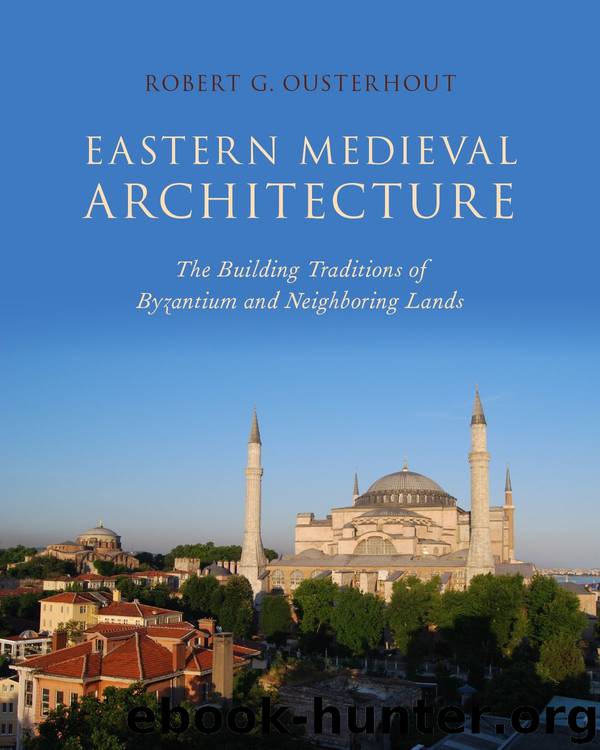Eastern Medieval Architecture by Robert G. Ousterhout

Author:Robert G. Ousterhout
Language: eng
Format: epub
ISBN: 9780190058401
Publisher: Oxford University Press
Published: 2019-07-26T16:00:00+00:00
Figure 16.6 Astvansankal, detail of the south wall of the gavit, showing incisions (highlighted) (author)
Figure 16.7 Astvansankal, drawing showing the full pattern of the incisions, with a reconstruction of the pattern, compared to the plan and elevation of the gavit (A. Kazaryan and R. Ousterhout, Muqarnas, 2000; and Mnatsakanian, Arhitektura, 1952)
Buildings becoming. As Vasileios Marinis astutely remarks, both buildings and the rituals they house are “continually in the process of becoming.”12 Those sites that have been examined archaeologically reveal a constant process of transformation, as discussed in the previous chapters: the Chora (Kariye Camii) and the Kyriotissa (Kalenderhane Camii) are noteworthy in this respect. The Byzantine buildings of Constantinople were constantly renewed, refurbished, and expanded. Basil I (r. 867–86) may have set the tone for later developments with his program of renewal:
Between his warlike endeavors…the Christ-loving emperor Basil, by means of continuous care and the abundant supply of all necessary things, raised from ruin many holy churches that had been rent asunder by prior earthquakes or had entirely fallen down or were threatening immediate collapse on account of the fractures [they had sustained], and to solidity he added [a new] beauty.13
The citations that follow are all too brief to determine if major changes in design were effected. In one example, however, we read that he “repaired and beautified” the Church of the Resurrection and of the martyr Anastasia at the Portico of Domninus by substituting a stone roof for a wooden one—clearly a change in design.
Several eleventh-century churches, described by the historian Michael Psellos in his Chronographia, are also instructive in this respect. Romanos III (r. 1028–34), for example, is said to have exhausted the treasury on the Church of the Theotokos Peribleptos: “One on top of another new parts were added, and at the same time another part would be pulled down. Often, too, the work would cease and then suddenly rise up afresh, slightly bigger or with some more elaborate variety.”14 While reflecting the indecisiveness and megalomania of the patron, the description suggests that the design of the building was altered several times during the process of construction, that the plan was not fixed from the beginning, and that the masons were willing to reformulate the basic design as they built. A similar situation is described with Michael IV (r. 1034–41) and the Monastery of the Kosmidion, built in an eastern suburb of Constantinople, where the emperor’s patronage arose from his hopes that the doctor-saints would heal his afflictions. Here the description indicates the renovation of an older structure: “Actually, not all of the foundations were laid by Michael, but he threw them over a wider area. There had been a sacred building on the spot before, although it was not noted for any magnificence, nor was it remarkable for its architectural style.” It is an interesting example of something new created in the framework of something old. Psellos reserves his greatest praise and his greatest condemnation for the church of St. George of Mangana, built by the emperor Constantine IX Monomachos (r.
Download
This site does not store any files on its server. We only index and link to content provided by other sites. Please contact the content providers to delete copyright contents if any and email us, we'll remove relevant links or contents immediately.
| Africa | Americas |
| Arctic & Antarctica | Asia |
| Australia & Oceania | Europe |
| Middle East | Russia |
| United States | World |
| Ancient Civilizations | Military |
| Historical Study & Educational Resources |
The Daily Stoic by Holiday Ryan & Hanselman Stephen(3110)
The Fate of Rome: Climate, Disease, and the End of an Empire (The Princeton History of the Ancient World) by Kyle Harper(2874)
People of the Earth: An Introduction to World Prehistory by Dr. Brian Fagan & Nadia Durrani(2619)
Ancient Worlds by Michael Scott(2493)
Babylon's Ark by Lawrence Anthony(2433)
Foreign Devils on the Silk Road: The Search for the Lost Treasures of Central Asia by Peter Hopkirk(2388)
The Daily Stoic by Ryan Holiday & Stephen Hanselman(2344)
India's Ancient Past by R.S. Sharma(2298)
MOSES THE EGYPTIAN by Jan Assmann(2275)
The Complete Dead Sea Scrolls in English (7th Edition) (Penguin Classics) by Geza Vermes(2135)
Lost Technologies of Ancient Egypt by Christopher Dunn(2111)
The Earth Chronicles Handbook by Zecharia Sitchin(2101)
24 Hours in Ancient Rome by Philip Matyszak(1973)
Alexander the Great by Philip Freeman(1961)
Aztec by Gary Jennings(1879)
The Nine Waves of Creation by Carl Johan Calleman(1784)
Curse Tablets and Binding Spells from the Ancient World by Gager John G.;(1768)
Before Atlantis by Frank Joseph(1740)
Earthmare: The Lost Book of Wars by Cergat(1715)
